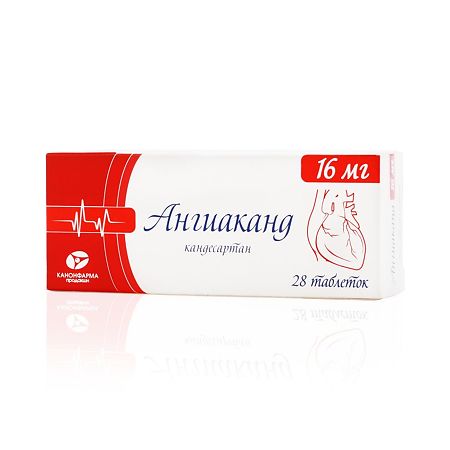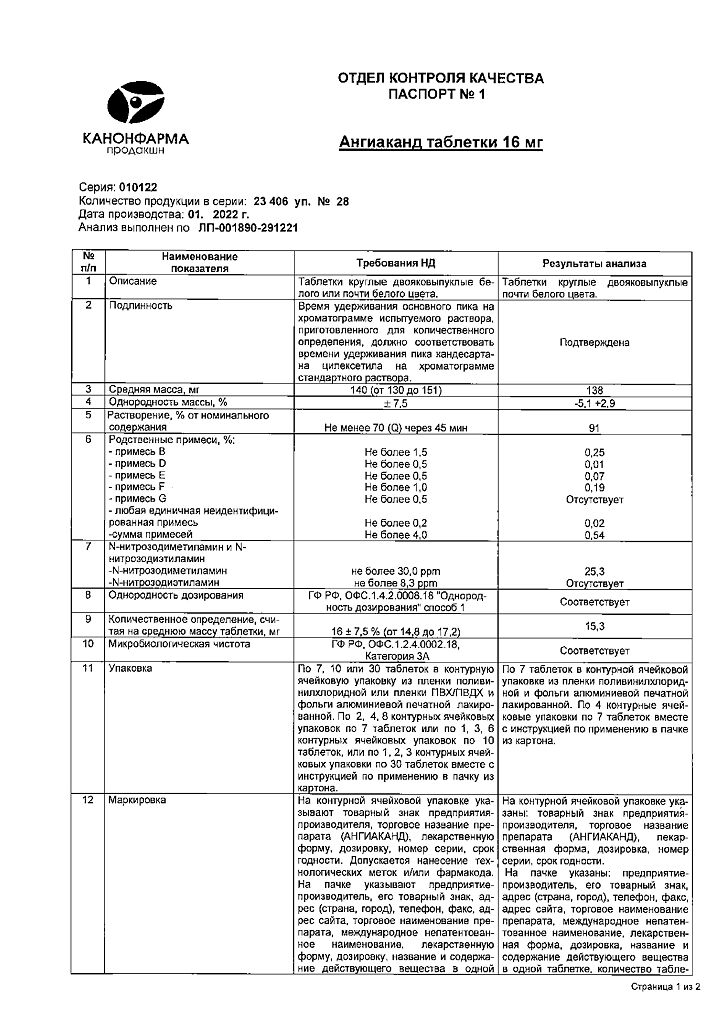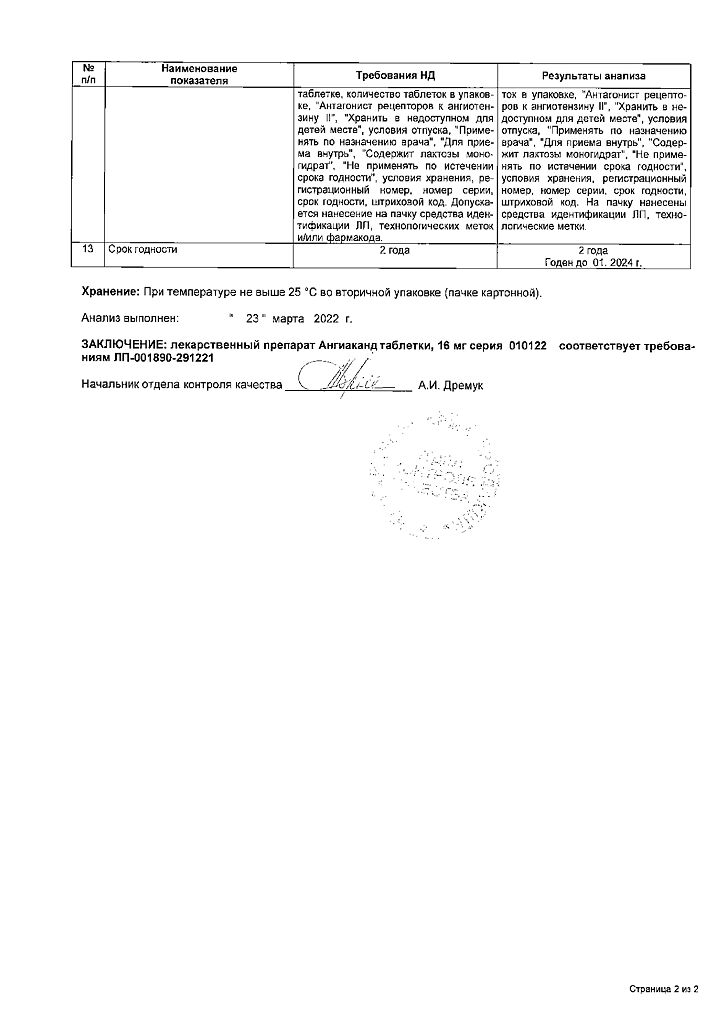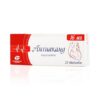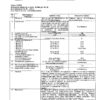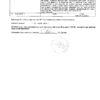No products in the cart.
Angiacand, tablets 16 mg 28 pcs
€10.94 €9.57
Description
Candesartan is a selective angiotensin II type 1 receptor antagonist (AT1-receptors), it forms a strong bond with them with subsequent slow dissociation. It has vasodilatory, hypotensive and diuretic effects. It does not show agonist properties (does not inhibit angiotensin converting enzyme (ACE) and does not lead to accumulation of bradykinin or substance P, does not bind with receptors of other hormones, does not block ion channels which participate in regulation of cardiovascular system functions).
As a result of blocking of AT1-receptors of angiotensin II there is a compensatory dose-dependent increase of renin activity, angiotensin I and angiotensin II concentration and decrease of plasma concentration of aldosterone.
Arterial hypertension
. The antihypertensive effect is due to a decrease in total peripheral vascular resistance (TPR), with no effect on heart rate (HR). No cases of severe arterial hypotension after the first dose of the drug and no “withdrawal” syndrome after discontinuation of therapy have been observed. The onset of antihypertensive effect after the first dose usually develops within 2 hours. Against the background of continuing therapy with the drug in a fixed dose, the maximum reduction in blood pressure (BP) is usually achieved within 4 weeks and is maintained throughout treatment.
Candesartan increases renal blood flow and does not change or increase glomerular filtration rate, whereas renal vascular resistance and filtration fraction decrease.
It does not affect glucose concentration and lipid profile in patients with arterial hypertension and type 2 diabetes. Provides dose-dependent gradual reduction of blood pressure.
Age and gender do not affect the effectiveness of the drug.
Chronic heart failure
. In patients with chronic heart failure and a reduced left ventricular ejection fraction of less than 40%, administration of candesartan contributed to decreased PPS and pulmonary capillary pressure, increased renin activity and plasma angiotensin II concentration, and decreased aldosterone concentration.
Pharmacokinetics
Candesartan is an oral prodrug. It is rapidly (via ester hydrolysis) converted to the pharmacologically active candesartan. Absolute bioavailability of candesartan after oral administration of candesartan cilexetil solution is about 40%.
The relative bioavailability of tablet versus oral solution is approximately 34%. Thus, the estimated absolute bioavailability of the tablet form is about 14 % and does not depend on the time of ingestion. Maximum concentration (Cmax) in blood serum is reached after 3-4 hours. Plasma concentration increases linearly with increasing dose in the therapeutic range (up to 32 mg). The volume of distribution is 0.13 l/kg. Blood plasma protein binding is 99.8%.
It is slightly metabolized in the liver (20-30%) with the participation of cytochrome P450 isoenzyme CYP2C9 with the formation of an inactive derivative. Terminal elimination half-life (T1/2) is 9 h. It does not cumulate. Total clearance is 0.37 ml/min/kg, with renal clearance of about 0.19 ml/min/kg. It is eliminated by kidneys and in bile mainly unchanged, to a small extent – as metabolite: by kidneys (by glomerular filtration and active tubular secretion) – 26% as candesartan and 7% – as inactive metabolite, in bile – 56% and 10%, respectively. After a single oral administration within 72 hours more than 90% of the dose is excreted.
In elderly patients (over 65 years) Cmax and area under the curve “concentration-time” (AUC) are increased by 50% and 80%, respectively, compared to younger patients. However, the antihypertensive effect and the incidence of side effects when using the drug do not depend on the age of patients.
In patients with mild to moderate renal dysfunction, Cmax and AUC are increased by 50% and 70%, respectively, whereas the T1/2 of the drug is unchanged compared to patients with normal renal function.
In patients with severe renal dysfunction, Cmax and AUC are increased by 50% and 110%, respectively, and the T1/2 of the drug is increased 2-fold.
In patients with mild to moderate renal impairment an increase in AUC of 23 % was observed.
Indications
Indications
arterial hypertension;
chronic heart failure and impaired left ventricular systolic function (decrease in left ventricular ejection fraction less than 40%) as additional therapy to angiotensin-converting enzyme (ACE) inhibitors or in case of intolerance to ACE inhibitors.
Pharmacological effect
Pharmacological effect
Candesartan is a selective antagonist of angiotensin II type 1 receptors (AT1 receptors), forms a strong bond with them, followed by slow dissociation. It has a vasodilating, hypotensive and diuretic effect. Does not exhibit agonist properties (does not inhibit angiotensin-converting enzyme (ACE) and does not lead to the accumulation of bradykinin or substance P, does not bind to receptors of other hormones, does not block ion channels involved in the regulation of the functions of the cardiovascular system).
As a result of blocking the AT1 receptors of angiotensin II, there is a compensatory dose-dependent increase in renin activity, the concentration of angiotensin I, angiotensin II and a decrease in the concentration of aldosterone in the blood plasma.
Arterial hypertension
The antihypertensive effect is due to a decrease in total peripheral vascular resistance (TPVR), while there is no effect on heart rate (HR). There were no cases of severe arterial hypotension after taking the first dose of the drug, or withdrawal syndrome after cessation of therapy. The onset of antihypertensive effect after taking the first dose usually develops within 2 hours. With continued therapy with the drug at a fixed dose, the maximum reduction in blood pressure (BP) is usually achieved within 4 weeks and persists throughout treatment.
Candesartan increases renal blood flow and does not change or increases the glomerular filtration rate, while vascular resistance in the kidneys and the filtration fraction are reduced.
Does not affect glucose concentration and lipid profile in patients with arterial hypertension and type 2 diabetes mellitus. Provides a dose-dependent gradual decrease in blood pressure.
Age and gender do not affect the effectiveness of the drug.
Chronic heart failure
In patients with chronic heart failure and a decrease in left ventricular ejection fraction of less than 40%, taking candesartan contributed to a decrease in peripheral vascular resistance and capillary pressure in the lungs, an increase in renin activity and the concentration of angiotensin II in the blood plasma, as well as a decrease in the concentration of aldosterone.
Pharmacokinetics
Candesartan is an oral prodrug. It is quickly converted (via ether hydrolysis) into the pharmacologically active candesartan. The absolute bioavailability of candesartan after oral administration of candesartan cilexetil solution is about 40%.
The relative bioavailability of the tablet formulation compared to the oral solution is approximately 34%. Thus, the calculated absolute bioavailability of the tablet form is about 14% and does not depend on the timing of meals. The maximum concentration (Cmax) in the blood serum is reached after 3-4 hours. The concentration in the blood plasma increases linearly with increasing dose in the therapeutic interval (up to 32 mg). Volume of distribution – 0.13 l/kg. Communication with blood plasma proteins – 99.8%.
Slightly metabolized in the liver (20-30%) with the participation of the cytochrome P450 isoenzyme CYP2C9 with the formation of an inactive derivative. The terminal half-life (T1/2) is 9 hours. Does not accumulate. Total clearance is 0.37 ml/min/kg, while renal clearance is about 0.19 ml/min/kg. Excreted by the kidneys and bile mainly unchanged, to a small extent – in the form of a metabolite: by the kidneys (by glomerular filtration and active tubular secretion) – 26% in the form of candesartan and 7% – in the form of an inactive metabolite, with bile – 56% and 10%, respectively. After a single oral dose, more than 90% of the dose is eliminated within 72 hours.
In elderly patients (over 65 years of age), Cmax and area under the concentration-time curve (AUC) increase by 50% and 80%, respectively, compared with younger patients. However, the antihypertensive effect and the incidence of side effects when using the drug do not depend on the age of the patients.
In patients with mild to moderate renal impairment, Cmax and AUC increase by 50% and 70%, respectively, while T1/2 of the drug does not change compared to patients with normal renal function.
In patients with severely impaired renal function, Cmax and AUC increase by 50% and 110%, respectively, and T1/2 of the drug increases by 2 times.
In patients with mild to moderate liver dysfunction, an increase in AUC of 23% was observed.
Special instructions
Special instructions
Before and during treatment, monitoring of blood pressure, renal function (plasma creatinine), potassium and lithium levels in the blood serum (with combined use of drugs) is necessary.
Arterial hypotension
In patients with chronic heart failure during therapy with Angiakand, arterial hypotension may develop. As with the use of other drugs that affect the RAAS, the cause of arterial hypotension in patients with arterial hypertension may be a decrease in blood volume, as observed in patients receiving large doses of diuretics. Therefore, at the beginning of therapy, caution should be exercised and, if necessary, correction of hypovolemia should be carried out.
Renal artery stenosis
In patients with bilateral renal artery stenosis or stenosis of the artery of a solitary kidney, drugs that affect the RAAS, in particular ACE inhibitors, may cause an increase in serum urea and creatinine concentrations. Similar effects can be expected when prescribing angiotensin II receptor antagonists.
Kidney transplant
There are no data on the use of candesartan in patients who have recently undergone a kidney transplant.
Renal dysfunction
During therapy with Angiakand, as with the use of other drugs that inhibit the RAAS, some patients may experience impaired renal function.
When using the drug Angiakand in patients with arterial hypertension and severe renal failure, it is recommended to periodically monitor the content of potassium and creatinine in the blood serum. Clinical experience with the use of candesartan in patients with severe renal impairment or end-stage renal failure (creatinine clearance less than 15 ml/min) is limited.
In patients with chronic heart failure, renal function should be periodically monitored, especially in patients aged 75 years and older, as well as in patients with impaired renal function. When increasing the dose of Angiakand, it is also recommended to monitor the content of potassium and creatinine in the blood plasma.
Combined use with ACE inhibitors in chronic heart failure
When using Angiakand in combination with ACE inhibitors, the risk of side effects, especially renal dysfunction and hyperkalemia, may increase. In these cases, careful observation and monitoring of laboratory parameters is necessary.
General anesthesia and surgery
In patients receiving angiotensin II receptor antagonists, hypotension may develop during general anesthesia and during surgery as a result of blockade of the RAAS. Very rarely, severe hypotension requiring intravenous fluids and/or vasopressors may occur.
Aortic and mitral valve stenosis (hypertrophic obstructive cardiomyopathy)
When using the drug Angiakand, like other vasodilators, patients with hypertrophic obstructive cardiomyopathy or hemodynamically significant stenosis of the aortic and/or mitral valve should be careful.
Primary hyperaldosteronism
Patients with primary hyperaldosteronism are usually resistant to treatment with antihypertensive drugs that affect the activity of the RAAS. In this regard, the drug Angiakand is not recommended for use in such patients.
Hyperkalemia
Clinical experience with other drugs that affect the RAAS shows that concomitant use of candesartan with potassium-sparing diuretics, potassium supplements or salt substitutes containing potassium, or other drugs that can increase the level of potassium in the blood (for example, heparin) may lead to the development of hyperkalemia in patients with arterial hypertension.
General
Patients whose vascular tone and renal function are predominantly dependent on the activity of the RAAS (for example, patients with severe chronic heart failure or kidney disease, including renal artery stenosis) are especially sensitive to drugs acting on the RAAS. The use of such drugs is accompanied in these patients by severe arterial hypotension, azotemia, oliguria and, less commonly, acute renal failure. The possibility of developing the listed effects cannot be excluded when using angiotensin II receptor antagonists. A sharp decrease in blood pressure in patients with coronary heart disease or cerebrovascular diseases of ischemic origin, when using any antihypertensive drugs, can lead to the development of myocardial infarction or stroke.
Impact on the ability to drive vehicles and machinery
During the treatment period, dizziness and weakness may occur, so care must be taken when driving vehicles and engaging in other potentially hazardous activities that require increased concentration and speed of psychomotor reactions.
Active ingredient
Active ingredient
Candesartan
Composition
Composition
1 tablet contains:
active substance:
candesartan cilexetil 16 mg;
excipients:
pregelatinized corn starch – 23.8 mg,
croscarmellose sodium (primellose) – 5 mg,
lactose monohydrate (milk sugar) – 90 mg,
magnesium stearate – 1 mg,
povidone-K30 – 4.2 mg.
Pregnancy
Pregnancy
Animal studies have shown kidney damage in the embryonic and neonatal periods with the use of candesartan. It is assumed that the mechanism of damage is due to the pharmacological effect of the drug on the renin-angiotensin-aldosterone system (RAAS).
In the human embryo, the blood supply system to the kidney, which depends on the development of the RAAS, begins to form in the second trimester of pregnancy. Thus, the risk to the fetus increases when candesartan is used in the second and third trimesters of pregnancy. Drugs that have a direct effect on the RAAS can cause developmental disorders in the fetus or have a negative effect on the newborn, even death, when used in the second and third trimesters of pregnancy.
Angiakand should not be used during pregnancy. If pregnancy is detected during drug treatment, therapy should be discontinued as quickly as possible.
It is unknown whether candesartan is excreted in breast milk. Due to possible undesirable effects on infants, Angiakand should not be used during breastfeeding.
Contraindications
Contraindications
hypersensitivity to candesartan or other components of the drug;
lactase deficiency, lactose intolerance, glucose-galactose malabsorption;
pregnancy;
lactation period;
primary hyperaldosteronism (resistance to therapy);
severe liver dysfunction and/or cholestasis;
age up to 18 years.
With caution
Severe renal failure (creatinine clearance (CC) less than 30 ml/min), bilateral renal artery stenosis, renal artery stenosis of a single kidney, history of a kidney transplant, hemodynamically significant stenosis of the aortic and mitral valve, cerebrovascular diseases, coronary heart disease, hypertrophic obstructive cardiomyopathy, decreased circulating blood volume (CBV), hyperkalemia.
Side Effects
Side Effects
Arterial hypertension, the most common side effects (≥1/100,
From the central nervous system: dizziness, weakness, headache.
From the musculoskeletal system, connective tissue: back pain.
Other: respiratory infections.
Laboratory indicators: decreased hemoglobin, hypercreatininemia, increased urea concentration in the blood, hyperkalemia, hyponatremia, increased ALT activity.
Chronic heart failure, most common side effects (≥1/100,
From the cardiovascular system: pronounced decrease in blood pressure.
From the urinary system: impaired renal function.
Laboratory changes: hypercreatininemia, increased blood urea concentration, hyperkalemia.
The following side effects have been reported during post-marketing use of candesartan (incidence less than 1/10,000):
From the hematopoietic organs: leukopenia, neutropenia and agranulocytosis.
Laboratory indicators: hyperkalemia, hyponatremia.
From the central nervous system: dizziness, weakness, headache.
From the digestive system: nausea.
From the liver and biliary tract: increased activity of liver transaminases, impaired liver function or hepatitis.
Allergic reactions: angioedema, skin rash, itching, urticaria.
From the musculoskeletal system, connective tissue: back pain, arthralgia, myalgia.
From the urinary system: impaired renal function, including acute renal failure in predisposed patients.
From the respiratory system: cough.
Interaction
Interaction
When candesartan was used in combination with hydrochlorothiazide, warfarin, digoxin, oral contraceptives (ethinyl estradiol/levonorgestrel), glibenclamide, nifedipine and enalapril, no clinically significant interactions were identified.
With the simultaneous use of lithium preparations with ACE inhibitors, a reversible increase in the concentration of lithium in the blood serum and the development of toxic reactions have been reported. Adverse reactions may also occur with the use of angiotensin II receptor antagonists, and therefore it is recommended to monitor serum lithium levels when using these drugs in combination.
With simultaneous use of angiotensin II receptor antagonists and NSAIDs, including selective COX-2 inhibitors and non-selective NSAIDs (for example, acetylsalicylic acid at a dose of more than 3 g / day), the hypotensive effect of candesartan may be reduced. As with ACE inhibitors, the simultaneous use of angiotensin II receptor antagonists and NSAIDs increases the risk of decreased renal function up to the development of renal failure, which leads to hyperkalemia in patients with impaired renal function. This combination should be used with caution, especially in elderly patients. All patients should receive sufficient fluids. It is necessary to monitor renal function at the beginning of therapy and thereafter.
Drugs that affect the RAAS may increase blood urea and creatinine concentrations in patients with bilateral renal artery stenosis or arterial stenosis of a solitary kidney.
Diuretics and other antihypertensive agents increase the risk of developing arterial hypotension Potassium-sparing diuretics, potassium supplements, salt substitutes containing potassium, and other drugs that can increase serum potassium levels (eg, heparin) increase the risk of developing hyperkalemia.
Candesartan is metabolized in the liver to a small extent (isoenzyme CYP2C9). Interaction studies have not revealed the effect of candesartan on the isoenzymes CYP2C9 and CYP3A4. The effect on other isoenzymes of the cytochrome P450 system has not been studied.
Overdose
Overdose
Symptoms: marked decrease in blood pressure, dizziness, tachycardia.
Treatment: symptomatic, lay the patient on his back, raise the lower limbs above the level of the head, if necessary, increase the circulating blood volume (CBV) by infusion of 0.9% sodium chloride solution, use of sympathomimetics. Hemodialysis is ineffective.
Storage conditions
Storage conditions
In a dry place, protected from light, at a temperature not exceeding 25 °C
Shelf life
Shelf life
2 years
Manufacturer
Manufacturer
Kanonpharma production CJSC, Russia
Additional information
| Shelf life | 2 years |
|---|---|
| Conditions of storage | In a dry, light-protected place at a temperature not exceeding 25 °C |
| Manufacturer | Kanonfarma Production ZAO, Russia |
| Medication form | pills |
| Brand | Kanonfarma Production ZAO |
Related products
Buy Angiacand, tablets 16 mg 28 pcs with delivery to USA, UK, Europe and over 120 other countries.

